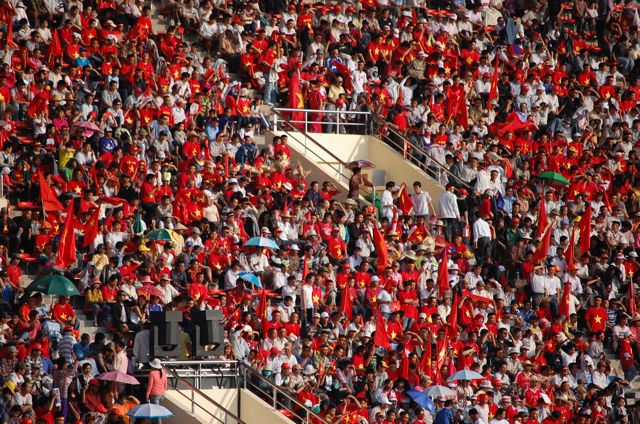With the opening ceremony still a week away, the SEA Games in Laos kicked off on Wednesday with the first football match, held to coincide with Lao National Day (Dec 2). In sublime irony, the first big game featured not Laos but its two much bigger neighbours and rivals, Thailand and Vietnam, themselves long-time protagonists on and off the field. The result, a 1-1 draw after a 90th minute Vietnamese penalty, perhaps flattered Vietnam, but for me the real story lay elsewhere, in the politics of affiliation.
In football terms this match was on paper a great one for the ‘neutrals’, pitting two of the tournament’s favourites against one another in the first group match. But clearly no one told the Lao crowd, which was overwhelmingly behind Vietnam. Many thousands bought red and yellow-star shirts and flags on sale (for a couple of dollars) on the road to the stadium and thousands more wore ‘Vietnam Champion’ headbands. This was not an idle affiliation of dress; the fans roared with the gusto of a home crowd, giving opposition and referee plenty of free character advice to boot.
The Vietnam bias was not unexpected – the Vientiane Times had predicted it after Vietnamese tour companies snapped up large numbers of tickets supposedly for Vietnamese fans – but the overwhelming ratio and its reasons were most striking. The crowd was not full of supporters from Vietnam, as the Vientiane Times had reported it would be, but mostly of Lao fans rooting for their eastern neighbour.
It is well known that, as revolutionary partners, the Lao and Vietnamese governments formalised a ‘special relationship’ in 1977 and that anti-Thai rhetoric was for many years part of its bedrock. It’s also well known that Lao people hold a deep and complex ambivalence towards Thailand. Despite linguistic and cultural similarities and a love of Thai TV and shopping, there remains a deep suspicion of Thailand’s size and power, which is no doubt stoked by the education system. This antipathy is arguably fueled further by an inferiority complex towards the Thai.
However, there are equally strong reasons to question the official rhetoric. There is great ambivalence – even racism – towards the Vietnamese in Laos and, while many Lao have Vietnamese backgrounds, this is not something Vietnamese-Lao usually make a big deal of. To the contrary, it is not uncommon for friends of Vietnamese-Lao to be unaware of their family history. So while superficially this football match might have pitted friend against enemy, there is much more to the story. Lao fans explanations of their loyalty reveal why.
Most fans explained simply that, while they have little time for both Thailand and Vietnam, they dislike the Thai more. ‘We hate/dislike the Thai more’, was the most common refrain. This was an adopted affiliation formed not out of common association but dislike. One young guy said he supported Vietnam since he was of Vietnamese background (sao viet) but he was the only one I spoke to who mentioned this (incidentally, he said he’d be cheering for Laos if they play Vietnam). All others predicated their loyalty on comparisons between Vietnam and Thailand, though not all spoke in terms of hatred or dislike. For instance, one young woman said that, while she didn’t ‘hate’ Thai people, they were hard/harsh (kheng) while the Vietnamese were gentle (orn).
But the most interesting explanation came from two women sitting near me, who spoke in terms of common kinship terms. Together they explained that Lao and Vietnam were ai nong kan (older brother, younger sibling; with Laos the latter) while Lao and Thailand were phi nong kan (a similar meaning but also friends – and also, of course, a common Thai term). When I said I thought these were pretty much the same, they expanded along the lines of: ‘ai nong are from the same family, very close to each other; phi nong are from different families, still friends but different families so further apart’.
These terms have also been used in party-state rhetoric, especially the refrain that Vietnam is first among ‘fraternal socialist countries’ (pathet sangkhomninyom ai nong). But the terms, like the match, seem to indicate more than regurgitation of state schooling, or else how to explain ‘hatred’ as an explanatory device?
The lesson for me concerns the tension between the universalist and nationalist motifs of the SEA Games. While the universalist themes of the games, which is to say regionalism, are drawn from the model of Olympic internationalism, they are very much grounded in the local and national histories of the region. So much so that the possibility of being ‘neutral’ at a game not including ones own team – common in football cultures elsewhere – never seemed to occur to anybody.
I’d be very happy to hear additional/alternative interpretations.
 Facebook
Facebook  Twitter
Twitter  Soundcloud
Soundcloud  Youtube
Youtube  Rss
Rss 